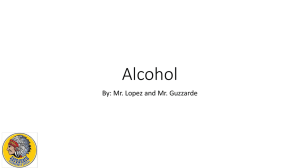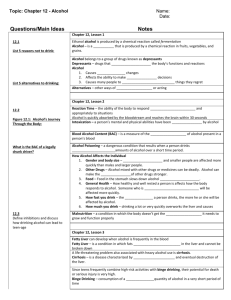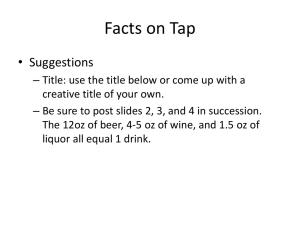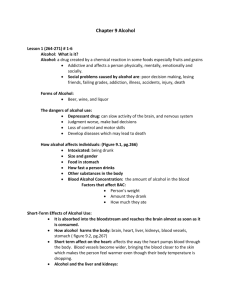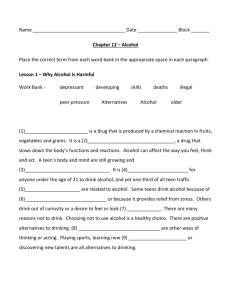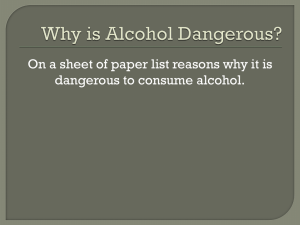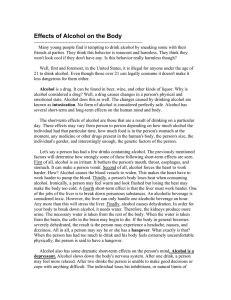Alcohol and Its Effects on the Body 1
advertisement
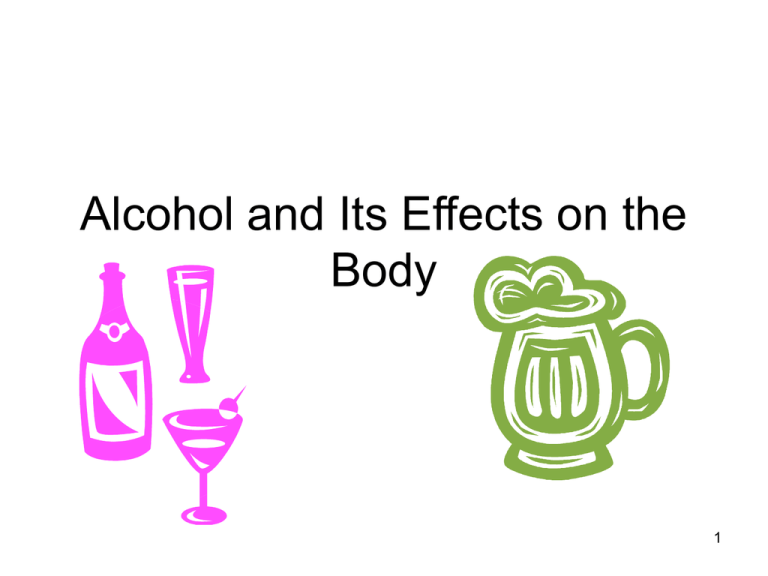
Alcohol and Its Effects on the Body 1 Alcohol poisoning is a severe elevation of blood alcohol concentration (BAC) that often results fron consuming large amounts of alcohol. A person is at great risk of alcohol poisoning if he/she: • Drinks excessively (4 or more drinks in one sitting) • Drinks after using medication or other drugs • Does not respond to being talked to or shouted at 2 • Does not respond when being pinched or prodded • Vomits while sleeping or passed out • Cannot stand up or remain standing unless aided by others • Won’t wake up despite repeated attempts • Has slow breathing (fewer than 6 breaths p/m. • Skin has a clammy feel or feels cool to the touch 3 What should you do if you suspect that someone has alcohol poisoning? – Don’t leave the person alone! – Call 911 – Place the person on their side to reduce the rick of chocking on vomit. – Direct someone to go look for the ambulance – If the person’s breathing becomes less than 6 breaths p/m perform CPR – Explain what you know to the paramedics 4 • Why Alcohol Affects People Differently Alcohol is a central nervous system depressant. The affects of alcohol are influenced by: 1. 2. 3. 4. 5. 6. 7. 8. 9. 10 5 • *females cannot drink as much as males at one sitting because of smaller body size, smaller volume of blood, and higher percentage of body fat that limits the amount of alcohol a woman’s body can handle. Also, a man’s stomach makes more of an alcohol-destroying compound that does a woman’s stomach, so less of what he drinks actually enters into his blood. 6 Physical Damage to Important Internal Organs Alcohol affects every part of the body. It is carried through the bloodstream to: The brain Stomach Internal organs Liver Kidneys Muscles Heart Large/Small Intestines Spleen Esophagus Eyes Skin It is absorbed very quickly ( in the body for several ____________. ) and can stay 7 Alcohol and the use of Other Drugs • When people pass out, their bodies continue to _______ alcohol. The amount of alcohol in the blood can reach dangerous levels, and they can die in their _____. • It is dangerous to _________ alcohol with other drugs, especially those that make you sleepy 8 Alcohol and Pregnancy • No level of alcohol use during pregnancy has been proven safe • Each year between 5,300 and 8,000 babies in the United States are born with fetal alcohol syndrome (FAS), a combination of physical and mental birth defects –leading known cause for ______ _______________ • Alcohol is the ____ leading cause for non-genetic handicapping of infants in America – small head, deformities of the face, hands, feet, internal organs, hearing, vision • Many babies with FAS also have a brain that is_____and abnormally formed, and most have some degree of mental disability. Many have poor coordination and a short attention span and exhibit behavioral problems. 9 Less Brain Matter at Birth This is permanent damage!!! 10 Alcohol and Its Effects by the Hour • Ethanol Dose (oz/hour) Function Impaired Physical State 1-4/hr Impaired judgment, lack of fine motor coordination, slowed reaction time, happy, talkative, boastful (too outgoing) 4-12/hr Lack of general motor coordination/reflexes, staggering gait, slurred speech, nausea, vomiting 12-16/hr Involuntary responses to stimulations, hyperthermia, general anesthesia of the body 16-24/hr Loss of most sensations, uncontrolled movement, self-protective reflexes, comatose 11 Long-term Effects of Alcohol on the Body 1. • • • 2. • • • To the Brain – ________ – inability to stop drinking Loss of ________ skills, memory Major ________ damage Cardiovascular Changes Damage to the _________ muscle Enlarged heart – from _______ __________ caused by alcohol High blood pressure – can cause heart attack/stroke 12 Liver Problems • One of the functions of the liver is to remove ___________ • Alcohol is viewed as a toxin to the ___________ • The liver can only handle approx. ___________ • More than that, the liver makes ______ from tthe alcohol • The fat is stored in the blood vessels, the heart, the liver and other areas of the body • The liver is the _________________ to be damaged by alcohol, the most serious condition being __________________ where the liver tissue is replaced by fat. 13 Long term effects 3. Liver problems – • ___________ – fats builds up and cannot be broken down – excess fat blocks the flow of blood to liver cells, leading to cell death • ________________ – inflammation of the liver cause by the toxic effects of alcohol • _______ – liver tissue is replaced with useless scar tissue. This disease can lead to liver failure and death. 14 Good/Healthy Liver 15 Unhealthy Liver 16 Alcohol’s effect on the body 4. Digestive system • Irritation – digestive lining is damaged; can lead to __________ and __________ of the stomach and esophagus 5. Pancreas Problems • Chemicals begin to destroy the pancreas, causing pain, vomiting, and can lead to _________________ 17 Terms used to describe people who drink • ______________________ – does not drink excessively. The person doesn’t behave inappropriately because of alcohol. The person's health is not harmed be alcohol over the long term. This applies only to adults as children and teen’s brains are not yet mature and cannot handle alcohol • __________________ – drinks only on social occasions. Depending on how alcohol affects the person’s life the person may be a moderate or a problem drinker. 18 • __________________ – drinks _______or more drinks in a short period. • Problem drinker –or alcohol abuser suffers social, emotional, family, job related, or other problems because of alcohol This person is on the way to alcoholism • Alcoholic- has the full blown disease of _________________. This person’s problems , caused by alcohol abuse, are out of control. 19 Alcoholism – • Is a disease in which a person has a _______ and/or a _____________dependence on alcohol. • ____________ behaviors - violent, aggressive, withdrawn, quiet • Craving – he/she cannot manage________ without the use • Loss of control – he/she cannot limit his drinking and is_____________ with alcohol • Physical dependence – without alcohol, will experience_______________ symptoms 20 The Disease of Alcoholism • An alcoholic will build a ____________ to alcohol - a need to drink increasingly greater amounts in order to feel its effects • An alcoholic will experience health/family, and legal problems – an alcoholic often suffers repeated injuries, receives multiple drunk driving citations, frequent arguments, poor relationships with family • An alcoholic may have a __________ link to alcoholism 21 Three Stages of alcoholism • Stage one – Early stage – Abuse of alcohol. Use for _________ reasons to relax, use for stress management, leads to psychological dependence. Drinks and gets intoxicated regularly, blackouts, memory loss – known as the “______________________” • Makes promises to quit but can’t keep them • Drinks often to ________________________ • Increased tolerance (needs more and more to feel the effects) • Personality change • More forgetful • More irritable 22 Stages of alcoholism • Stage two – Middle stage – physically dependent on alcohol, becomes central focus, performance of job, school work, etc, suffers. Makes _____________ and ___________ others • Tries to deny or hide drinking • Drinks when alone • Drinks in the morning • Signs of drinking more noticeable • Drinks at work or at school • Harder to feel “high” no matter how much consumed 23 • Drinking is now a daily necessity • Stages of alcoholism Stage 3 – Final stage • • • • drinking is the most important thing in a person’s __________. The person is addicted to the drug and his or her life is out of control, although frequently he/she does not realize or acknowledge this fact. Because the liver is damaged, less alcohol is required to produce intoxication which is known as ____________ _________________. Severe withdrawal symptoms if alcoholic tries to stop Isolation from friends and family Loneliness L_______________________ Never seems to eat 24 The next day… Hangover- symptoms that can occur the next day after being _____________: • Sensitivity to _______________ • Headache • Nauseous • Body aches • Bad breath 25 Effects on Family and Society • Major factor in the four leading causes of accidental death – car accidents, falls, drowning, house fires • Plays a major role in violent crimes – homicide, forcible rape, robbery • 40% of violent crimes are alcohol related • 2/3’s of victims who encounter domestic violence report that alcohol was a factor • Nearly half of all homicide victims have alcohol in their bloodstream • Codependency – codependents learn to ignore their own needs and focus their energy and 26 emotions on the needs of the alcoholic Treatment • The process of learning to live an alcohol free life is called __________ • Approx. ______ of all alcoholics who try to recover are successful • Many resources are available to help people who have a drinking problem. Help is also available to the families and friends 27 Treatment • ____________ – helps family and friends of the alcoholic • ___________________ – provides help for the alcoholic • Nat’l. Asso. Fir Children of Alcoholics – provides help for children • Al - ateen 28 Teens and alcohol • Alcohol related traffic crashes are a major cause of death among teens. Alcohol use also is linked with youthful deaths by drowning, suicide, and homicide • Teens who use alcohol are more likely to become sexually active at earlier ages, to have sexual intercourse more often, and to have unprotected sex than teens who do not drink • Young people who drink are more likely than others to be victims of vilent crime, including rape, aggravated assault, and robbery. 29 • Teens who drink are more likely to have problems with school work and school conduct • An individual who begins drinking as a young teen is four times more likely to develop alcohol dependence than someone who waits until adulthood to use alcohol 30 Need Help??? • Alcoholic anonymous – 412-471-7472\ www.alcoholics-anonymous.org • Al-Anon/Alateen Family Group 412-5725141 www.al-anon.alateen.org • Crisis Center North 412-364-5556 • Gateway Rehabilitation Center Main office – 412-766-8700, North Hills – 724776-4844 31
